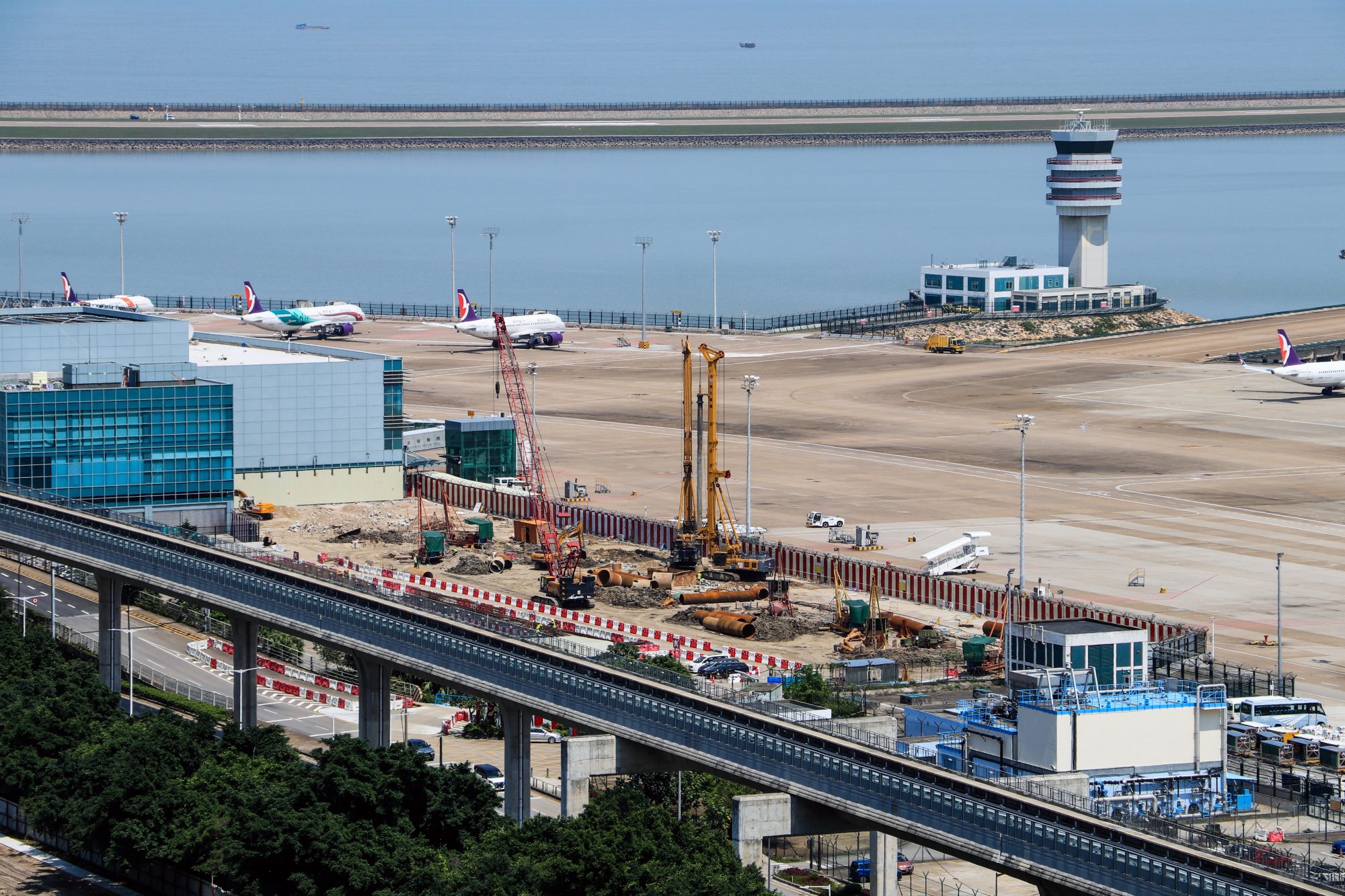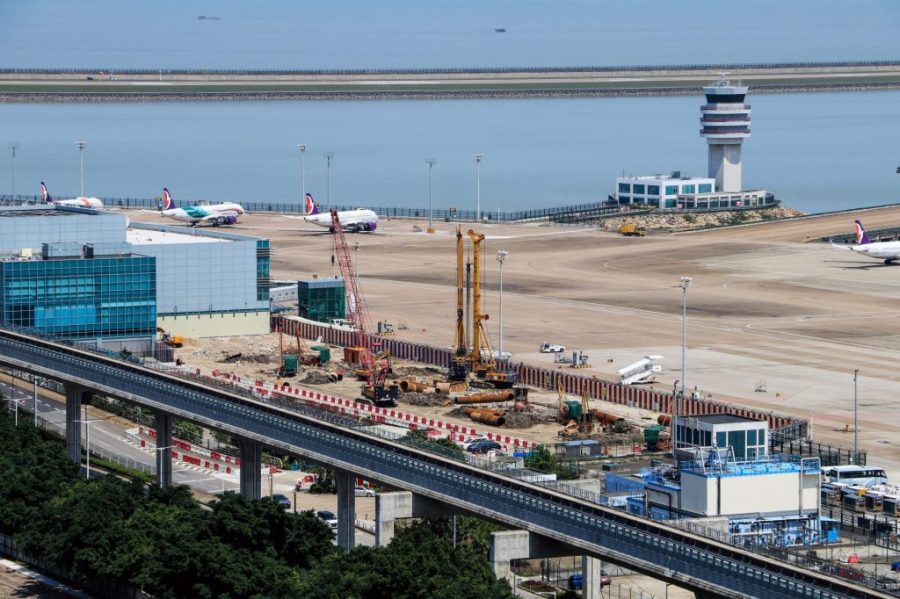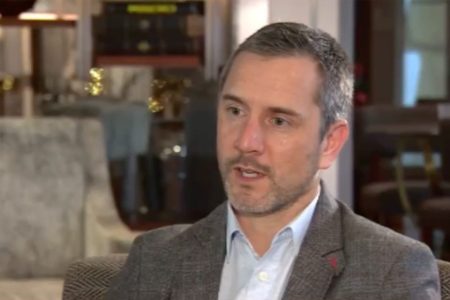Macao’s civil aviation chief said last week the local government expects to submit a number of reports next July to the central government to obtain the latter’s green light for land reclamation so that the local airport’s expansion project can get off the ground, such as an environmental assessment report and a water flow report.
The local government had asked Beijing to approve the airport extension-related land reclamation project several years ago, but nothing came of it.
Macao Civil Aviation Authority (AACM) President Simon Chan Weng Hong raised the issue during a one-day Q&A session in the legislature’s hemicycle on Friday when Secretary for Transport and Public Works Raimundo do Rosário and other senior officials under his portfolio answered questions from lawmakers about their respective areas’ policy guidelines for next year.
‘No 2nd runway’
Chan all but ruled out the possibility of a second runway for the airport. He also said he expected airport operator CAM to complete the initial design of the government’s project to convert part of the Taipa ferry terminal into the adjacent airport’s Terminal 2 within two months.
The local government first told the media in 2017 that it had asked the central government to approve a land reclamation project required for the airport’s expansion, in response to the rising number of passengers.
According to the AACM website, the local government applied to the State Council Hong Kong and Macau Affairs Office (HKMAO) in February 2017 for the reclamation of 172 hectares (1.72 square kilometres) for the expansion of the airport. Local government officials presented the proposed airport expansion and land reclamation plan to HKMAO officials and those from several ministries and commissions of the central government in Beijing in July that year.
Afterwards, the Macao Civil Aviation Authority carried out a water flow study, and reduced the reclamation area to 149 hectares, in line with the opinions from the various ministries and commissions, according to the website.
The local government is proposing to reclaim land in the waters between the airport’s two taxiways that link the runway built on a man-made island and the apron, the website points out.
According to the website, Rosário and Chan visited the Hong Kong and Macau Affairs Office in Beijing in December 2018 when they listened to opinions and instructions from HKMAO officials concerning the expansion of the local airport. In March last year, the local government submitted the revised version of its airport development plan together with other supplementary information, the website says.
In August last year, the Hong Kong and Macau Affairs Office replied to the local government that the respective ministries and commissions back the Macao government’s plan to extend the airport and also agree with the relevant information that it has submitted.
Afterwards, the Environmental Protection Bureau (DSPA), Macao Civil Aviation Authority and airport operator CAM started to co-draft the final plan for the airport’s land reclamation project and an environmental assessment report and prepare other kinds of information, the website says, adding that the work is expected to be completed next year when the local government will submit a “formal” application to the central government for the airport-related land reclamation.
According to the AACM website, the first phase of the airport expansion project is designed for an annual passenger movement of 11 million, based on the expected number of passengers in 2025, while the second phase is for an annual passenger movement of 15 million for the 2031-2037 period.
The airport’s designed maximum capacity had been six million passengers per year since it started operating in November 1995, before its terminal was expanded in 2018 when the maximum capacity was raised to the current 7.8 million passengers per year.
North & south extension
The number of passengers broke the six million mark in 2016. The north extension of the current passenger terminal building got off the ground in November 2015 and came into use in February 2018. The number of passengers broke the 7.8 million mark that year, after which airport operator CAM decided to extend the passenger terminal building in the property’s southern section. The south extension project got off the ground in March this year, and is slated to be completed by the end of next year. The south extension will increase the passenger terminal building’s capacity to 10 million passengers per year, CAM has said.
Same as the north extension, the south extension will also be integrated with the existing passenger terminal building.
Terminal 2
As there is still no timetable for when the airport’s land reclamation project can get off the ground, the local government is now planning first to convert part of the Taipa Ferry Terminal into Macao International Airport’s Terminal 2, with the aim of tackling the airport’s capacity constraints by “making good use” of the large ferry terminal in Pac On.
Government officials, including Rosário and Chan, briefed lawmakers about the Terminal 2 project in two meetings of the legislature’s Follow-up Committee for Land and Public Concession Affairs earlier this year. The officials told the committee that the government plans to convert some 20,000 square metres of the Taipa Ferry Terminal, which covers an area of 230,000 square metres, into the airport’s Terminal 2.
The officials told the two meetings that Terminal 2 will initially comprise check-in counters for at least four airlines and be connected to the apron through a 660-metre-long special passage – a restricted area through which passengers will have to travel by bus to the apron to board their plane. Terminal 2 is planned to handle 1.5 to two million passengers annually.
The airport recorded 9.6 million passengers last year.
The officials also told the two meetings that the design and construction of the Terminal 2 project will be carried out by airport operator CAM, in which the government has a 55 per cent stake.
Airport development work continues despite COVID-19
During Friday’s plenary session, Chan underlined that the local government has never stopped work on its airport development project in spite of the COVID-19 pandemic which has affected Macao since late January.
The local government is carrying out various tasks in preparation of applying to the central government to be allowed to reclaim land for the airport expansion project. The preparatory work includes the drafting of an environmental assessment report and a water flow report, as well as other kinds of reports.
According to Chan, the local government expects to complete its various reports on the land reclamation and formally submit them to the central government in a “formal” application procedure next July. The application will ask Beijing for official approval of the airport-related land reclamation project.
Chan also said the government and airport operator CAM were jointly working on the initial design of the Terminal 2 project, striving to complete this task within two months. Chan also reaffirmed that a large-scale public transport hub will be set up in Pac On in the future where the airport, Taipa Ferry Terminal, Light Rail Transit (LRT) and the future 4th Macao-Taipa bridge will all be linked.
Chan also said it would be “almost impossible” for the airport to have a second runway, partly because it would involve additional land reclamation, apart from putting further pressure on air traffic control management.
The local government has said in the past that there is no need for a second runway.
Aviation sector hit hard by COVID-19 pandemic
Chan also said that before the COVID-19 pandemic, the airport had 60 regular routes operated by over 30 airlines and, on average, 200 flights per day. Right now, based the civil aviation sector’s gradual recovery in the past few months, the airport has 30 flights per day, with 21 destinations served by six airlines.
Macao’s aviation sector has been hard hit by the COVID-19 pandemic since early this year. The sector’s performance has gradually improved since September’s resumption of the central government’s Individual Visit Scheme (IVS) for all mainlanders to travel to Macao. However, tourism sector representatives say that the current IVS numbers are still much lower than before the pandemic.
Chan also said the airport’s future development would focus on developing more regional routes and attracting more business jets.
(The Macau Post Daily/Macao News)
Photo by Macau Photo Agency






